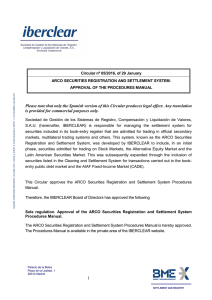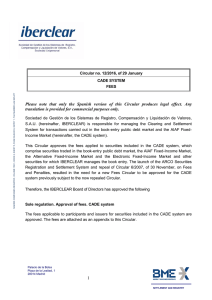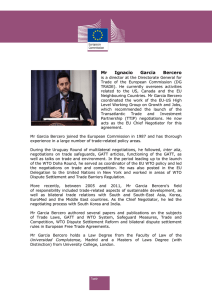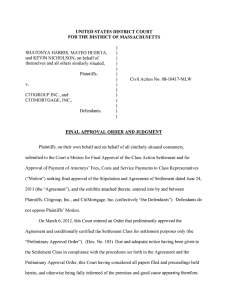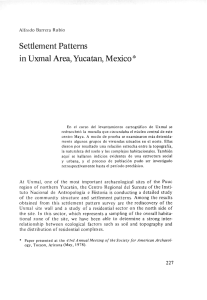lecture3 foundation settlement -161028163727
Anuncio
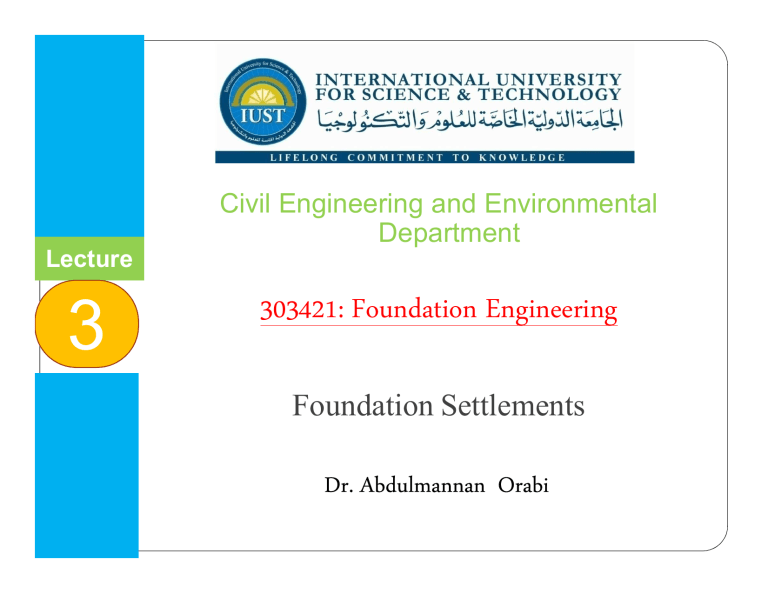
INTERNATIONAL UNIVERSITY FOR SCIENCE & TECHNOLOGY م وا ا ا و ا Civil Engineering and Environmental Department Lecture 3 303421: Foundation Engineering Foundation Settlements Dr. Abdulmannan Orabi References ACI 318M-14 Building Code Requirements for Structural Concrete ( ACI 318M -14) and Commentary, American Concrete Institute, ISBN 978-0-87031-283-0. Bowles , J.,E.,(1996) “Foundation Analysis and Design” -5th ed. McGraw-Hill, ISBN 0-07-912247-7. Das, B., M. (2012), “ Principles of Foundation Engineering ” Eighth Edition, CENGAGE Learning, ISBN-13: 978-1-305-08155-0. Syrian Arab Code for Construction 2012 Dr. Abdulmannan Orabi IUST 2 Introduction Foundation settlements must be estimated with great care for buildings, bridges, towers, power plants, and similar high-cost structures. For structures such as fills, earth dams, levees, braced sheeting, and retaining walls a greater margin of error in the settlements can usually be tolerated. Dr. Abdulmannan Orabi IUST 3 Introduction The settlement of a shallow foundation can be divided into two major categories: (a) elastic, or immediate, settlement and (b) consolidation settlement. Immediate, or elastic, settlement of a foundation takes place during or immediately after the construction of the structure. Dr. Abdulmannan Orabi IUST 4 Introduction Consolidation settlement or those that are timedependent and take months to years to develop. Pore water is extruded from the void spaces of saturated clayey soils submerged in water. The total settlement of a foundation is the sum of the elastic settlement and the consolidation settlement. Dr. Abdulmannan Orabi IUST 5 Introduction Consolidation settlement comprises two phases: primary and secondary. Secondary consolidation settlement occurs after the completion of primary consolidation caused by slippage and reorientation of soil particles under a sustained load. Dr. Abdulmannan Orabi IUST 6 Introduction Primary consolidation settlement is more significant than secondary settlement in inorganic clays and silty soils. However, in organic soils, secondary consolidation settlement is more significant. Dr. Abdulmannan Orabi IUST 7 Immediate settlement Immediate settlement analyses are used for all fine-grained soils including silts and clays with a degree of saturation S ≤ 90 percent and for all coarse-grained soils with a large coefficient of permeability. Dr. Abdulmannan Orabi IUST 8 Immediate settlement Settlement Based on the Theory of Elasticity The elastic settlement of a shallow foundation can be estimated by using the theory of elasticity. From Hooke’s law we obtain = Where: = 1 ∆ − ∆ − ∆ = = ℎ !" ! # $ = ! % % !" # !" ! = &! ! ' $ ! !" ℎ ! ∆ ,∆ , ∆ = $ $ % ! the net applied foundation load in the x, y, and z directions, respectively Dr. Abdulmannan Orabi IUST 9 Immediate settlement Settlement Based on the Theory of Elasticity The settlement of the corner of a rectangular base of dimensions B' * L' on the surface of an elastic half-space can be computed from an equation from the Theory of Elasticity as , follows: 1 − ' = )* + Dr. Abdulmannan Orabi - -. IUST 10 Immediate settlement Settlement Based on the Theory of Elasticity = )* +' )* = # !" ! = G $ F +' = $ - = "% " , - -. %$ % !" % % % !" ! ! !" ! $ E% ' F E $ 1 !$ , /ℎ ℎ 0 ! , thickness of ' + "!% ! 0 ℎ D. stratum H , Poisson’s ratio . 1−2 - = -H + -, 1− Dr. Abdulmannan Orabi # 0$ 1− IUST 11 Immediate settlement Settlement Based on the Theory of Elasticity The influence factors I1 and I2 can be computed using equations given by Steinbrenner as follows: 1 -H = L K -, = where N ,O 1 + L, + 1 L 1+ PH 1' L= ' + Dr. Abdulmannan Orabi L, + L, + M , M, +1 + L + L, + 1 L + L, + M , + 1 Q PH N QR S NR SH M= +' 1 + M, +H ' IUST 1, ' $ +H ' 1H ' 12 Immediate settlement Settlement Based on the Theory of Elasticity Theory The influence factor -. is from the Fox equations, which suggest that the settlement is reduced when it is placed at some depth in the ground, depending on Poisson's ratio and L/B. D. -. = 0.66 + Dr. Abdulmannan Orabi P .HV 1 + 0.025 ( + 12 + IUST − 4.6) 13 Immediate settlement Settlement Based on the Theory of Elasticity Theory = )* +' 1− , - -. This equation is strictly applicable to flexible bases on the half-space. If your base is "rigid" you should reduce the Is factor by about 7 percent (that is, Isr = 0.931 Is). Dr. Abdulmannan Orabi IUST 14 Immediate settlement Settlement Based on the Theory of Elasticity Theory Note that the stratum depth actually causing settlement is not at + =→ ∞ but is at either of the following: a. Depth z =5B where B = least total lateral dimension of base. b. Depth to where a hard stratum is encountered. ]^ Dr. Abdulmannan Orabi = a ∑`aH ` ` IUST 15 Immediate settlement Settlement of Sandy Soil: Use of Strain Influence Factor The settlement of granular soils can also be evaluated by the use of a semiempirical strain influence factor proposed by Schmertmann et al. (1978). Dr. Abdulmannan Orabi IUST 16 Immediate settlement Settlement of Sandy Soil: Use of Strain Influence Factor According to this method the settlement is = bH b, )* − ) c /ℎ $ : bH = 1 − 0.5 ) )* − ) b, = 1 + 0.2 !F )* = $ e ℎ ) = f D. = "" - = $ "% Dr. Abdulmannan Orabi G G = !$ # 0.1 $ ! " = !" "!% $ " !$$ G ∆ !$ "!$ ! , ℎ - 0 ℎ !" "!% ! " !$ "!$ = # !" "!% $ 0 ! ! % % % !" ! ! !$ IUST 17 Immediate settlement Settlement of Sandy Soil: Use of Strain Influence Factor The following relations are suggested to determine the strain influence factor - 0.1 1 - = 0.1 + − 1 ≤ 0.2 9 + i=0 j $ ! !" iH "!$ - j $ ! !" i, "!$ - = 0 k H , 0.5+ 1 −1 ≤+ 9 + 2+ 1 = 2+ + − 1 ≤ 4+ 9 + = 0.5+ + The maximum value of Iz can be calculated as ) H = "" G $ Dr. Abdulmannan Orabi 0 ℎ iH IUST - k = 0.5 + 0.1 )* − ) )H 18 Immediate settlement Settlement of Sandy Soil: Use of Strain Influence Factor Dr. Abdulmannan Orabi IUST 19 Primary Consolidation Settlement On the basis of the one-dimensional consolidation settlement equations we write l(m) where : = ∆ = 1+ ∆ℎ *− = ℎ 1+ Dr. Abdulmannan Orabi * ` * IUST 20 Primary Consolidation Settlement ∆H= s Vvo = eoVs Voids Vvi = (e i ) Vs Vs Voids Vs Solids Solids After Before V S V To = 1+ eo V Ti 1+ ei = V o 1+ eo Dr. Abdulmannan Orabi V e i =e o S = − (1 + e IUST V Ti 1+ e o i ∆ h ) h 21 Primary Consolidation Settlement The consolidation settlement Sc due to this average stress increase can be calculated as follows: n!$ !$ # ! = n!$ !G $ ! = Dr. Abdulmannan Orabi l 1+ ! 1+ ℎ * ℎ * !F !F ! ' ^* ' ^* + ∆ ' ^* # ^ #/ ℎ + ∆ ' ^* IUST ' ^* + ∆ ^ ≤ &l' ^ 22 Primary Consolidation Settlement n!$ !G $ ! ! ' ' ≤ & ^* l ≤ = where 1+ ℎ * !F bl = ! 0$ b = / * = &l' = 0$ ! ' ^* &l' + ' ^* F G! ! + ∆ ! $ o ^ l 1+ ℎ * o !F ! !" ℎ ! 0$ ℎ= ℎ !" ℎ ' "" ^* = !G $E%$ ℎ !" ℎ Dr. Abdulmannan Orabi #/ ℎ %$ ' ^* + ∆ &l' # # # $ G 0$ %$ # # $ IUST ^ # $ 23 Primary Consolidation Settlement ∆ = G $ F $ # $ % E# ℎ ! ^ 0$ %$ ! ℎ $% ! !" "!% ! # Note that the increase in effective pressure, ∆ ^ , on the clay layer is not constant with depth: The magnitude of ∆ ^ will decrease with the increase in depth measured from the bottom of the foundation. However, the average increase in pressure may be approximated by 1 ∆ ^= p+4 k+ q 6 Dr. Abdulmannan Orabi IUST 24 Primary Consolidation Settlement Primary consolidation settlement calculation where : p, k , and q are, respectively, the pressure increases at the top, middle, and bottom of the clay layer that are caused by the construction of the foundation. Dr. Abdulmannan Orabi B Ground surface q Ground water table p k h Clay layer q z IUST 25 Secondary Consolidation Settlement At the end of primary consolidation (i.e., after the complete dissipation of excess pore water pressure) some settlement is observed that is due to the plastic adjustment of soil fabrics. This stage of consolidation is called secondary consolidation. A plot of deformation against the logarithm of time during secondary consolidation is practically linear as shown in Figure. Dr. Abdulmannan Orabi IUST 26 Secondary Consolidation Settlement From the figure , the secondary compression index can be defined as ∆ br = !F , − !F where br = ∆ = ℎ H ! , $# ! 0$ F !" G! = Dr. Abdulmannan Orabi $ ! ! IUST H o 27 Secondary Consolidation Settlement The magnitude of the secondary consolidation can be calculated as l br' ℎ = !F , / H where br' m br = 1+ = G! ℎ= ℎ m $ ! Dr. Abdulmannan Orabi ℎ !" ℎ # !" 0$ # $ IUST $# ! ! ! 28 Secondary Consolidation Settlement Secondary consolidation settlement is more important in the case of all organic and highly compressible inorganic soils. In overconsolidated inorganic clays, the secondary compression index is very small and of less practical significance. Dr. Abdulmannan Orabi IUST 29 Time Rate of Consolidation Degree of consolidation The average degree of consolidation for the entire depth of the clay layer at any time t can be expressed as , where t= t= = . = " "$! p . =1− G $ F p Dr. Abdulmannan Orabi 0$ 2 1 F$ uv !" ℎ $# ! w %* !" ! xy % ! # $ !" ℎ # $ ! ! IUST ! 30 Time Rate of Consolidation Degree of consolidation The values of the time factor and their corresponding average degrees of consolidation for the case presented in may also be approximated by the following simple relationship: K n!$ t = 0 ! 60%, e^ = 4 t% 100 , n!$ t > 60%, e^ = 1.781 − 0.933 !F 100 − t% e^ = Dr. Abdulmannan Orabi b^ , uv IUST 31
